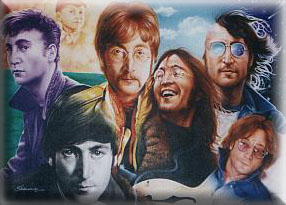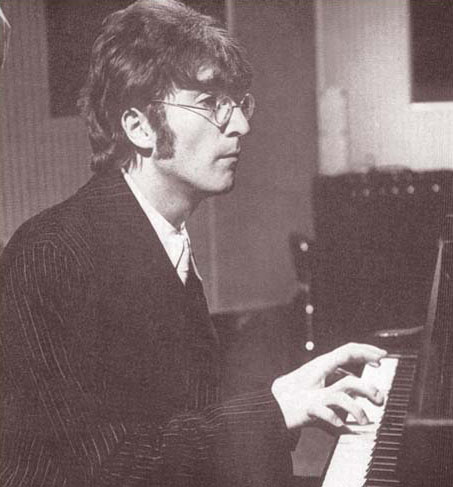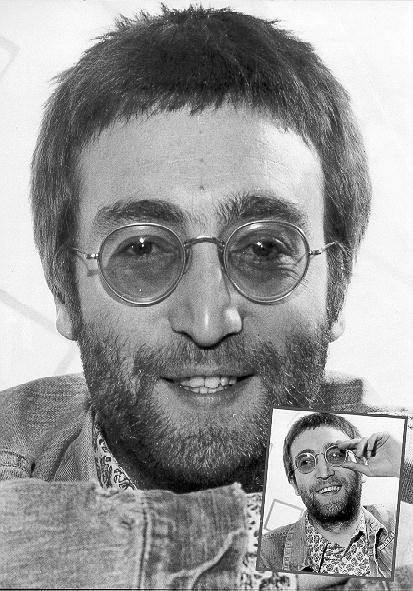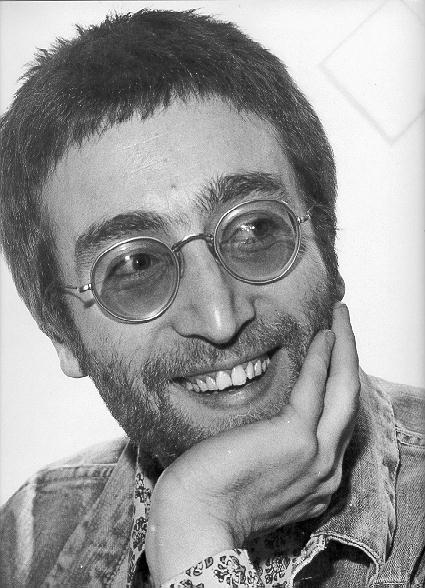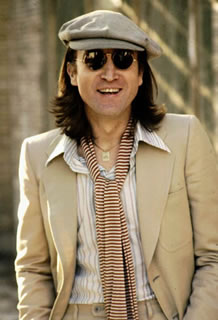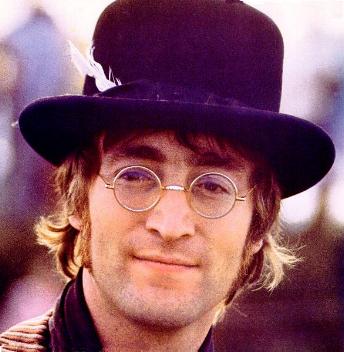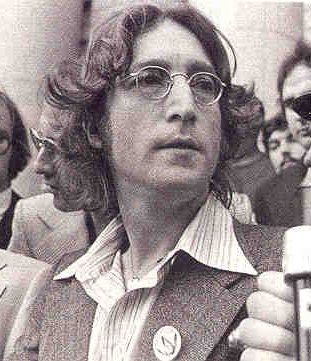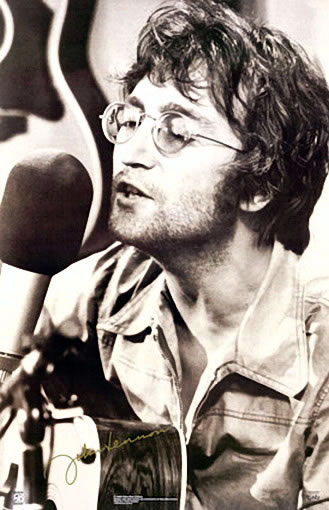|
October 8, 1940 - December 8, 1980 John (John Winston
Lennon) was born in Liverpool, England. He grew up with his aunt.
John Lennon started the Beatles when he joined Paul McCartney
and George Harrison to his small group. They didn't know much
about guitars, so each other tought the rest new cords and techniques.
The group got it's big start in 1963 with their first album, Please,
Please Me. He lent his writing skill to the group with the song
Ask Me Why. John Winston Lennon,
The founder of the group, was born during a German bombing raid
on October 9, 1940, to Julia Stanley and Alfred Lennon. They had
married in 1938, but Alfred, a merchant seaman, was absent for
long stretches during Lennon's early years. Julia was described
as a free if somewhat flighty spirit. It was decided in the spring
of 1941 that John would have the greatest chance of a stable home
life if he were brought up by Julia's childless sister Mary Elizabeth,
known as Mimi, and her husband George Smith, in Woolton, a Liverpool
suburb. Thus Lennon was insulated from the breakup of his parents'
marriage in 1942. He saw his father occasionally until he was
five, whereupon Alfred disappeared until 1965, when a London newspaper
reported that while his son was making millions, Alfred Lennon
was a dishwasher in a hotel. They maintained an odd, rocky relationship
thereafter. The qualities that made Elvis so appealing to people of Lennon's age struck their parents as cause for grave concern. Just when their kids seemed to be turning out right, wearing crew cuts and dancing to saccharine ballads, here was a Southern truck driver with jet black hair stacked elaborately but with a touch of waywardness, gyrating behind a guitar and growling 'you ain't not'n but a hound dog'. All these new musicians made a profound impression on Lennon and the other Beatles-to-be. Several of their songs remained in the group's performing repertory; in fact, their final public concert, at Candlestick Park in San Francisco, on August 29, 1966, began with Berry's 'Rock and Roll Music' and ended with Little Richard's 'Long Tall Sally'. More immediately, though, the tide of American rockers created a boom market for guitars in Liverpool, England. One eager customer was John Lennon. Julia, who played the banjo, taught him his first chords. Lennon saw music as a social evocation from the start, and in March 1957, soon after he got his first guitar, he gathered some friends and formed his own skiffle band. For a week, the band was known as the Black Jacks; thereafter it was Quarry Men, in honor of the Quarry Bank High School for Boys, where Lennon was an increasingly indifferent student. The Quarry Men had a fairly fluid line-up and performed at parties and contests in the spring of 1957 with Lennon as its lead guitarist and singer. Correctly assuming that Mimi would object to his fronting a band, Lennon and his friends rehearsed at Julia's house. It was entirely by accident that Mimi discovered her nephew's secret life. On July 6, 1957 she attended the summer fete at St. Peter's Parish Church, and was horrified to discover that what she later described as an 'eruption of noise' was produced by Lennon and the Quarry Men. A recording of Lennon singing two songs that day - Arthur Gunter's 'Baby, Let's Play House', which he knew from an Elvis Presley record, and 'Puttin' on the Style', a Lonnie Donegan hit - turned up in a private collection in 1994. There are also photographs of the band in action on that date. And a local newspaper referred briefly to the Quarry Men performance. It is extraordinary that a performance by a band of teenagers in Liverpool suburb in the late 1950's should have been so well documented - and all the more so because the date turned out to be a milestone in the Beatles' history. It was at this church fete, between Quarry Men sets, that Ivan Vaughan, one of the several tea-chest bassists in the group and a classmate of McCartney's at the Liverpool Institute Grammar School, introduced Lennon and McCartney. John loved the music of Elvis Presley and it had a profound effect on The Quarry Men's performances. At one point they had been known as folkies but soon had developed into a rock'n'roll group. As for John and Paul, their musical relationship grew stronger and soon they became a song writing team coming up with their now legendary vocal-harmony style. Around this time there was a lot of pressure for the group to change their name. At that time many bands had the leader's name in front of the group name. At one point they did change their name to "Johnny & The Moondogs" but they quickly changed their minds and went back to The Quarry Men. Soon John would come up with the legendary name "The Beatles" and kept it as the band's name. In September 1957, John enrolled in "The Liverpool Art College." There he met, and would later marry, Cynthia Powell. He also met Stuart Sutcliffe, who became his best friend and the "Fifth Beatle." In 1960, with new band member Pete Best in tow, The Beatles traveled to Hamburg for the first time. Stuart had little interest in music and could barely play the bass so after Hamburg he decided to go back to art college. John, although disappointed, remained good friends with Stuart and Paul took over as bass player. In 1961, The Beatles first met Brian Epstein in "The Cavern Club" after one of their many performances there. Later that year Brian Epstein became The Beatles manger and the following year they signed with Parlphone after George Martin suggested getting a new drummer. Brian and The Beatles decided on Ringo Starr. While all this was going on John found time to marry Cynthia on August 23, 1962 and she gave birth to their son Julian on April 8, 1963. The Beatles were enjoying international success when John's first book "In His Own Write" was published on March 23, 1964 and became a best-seller. On June 24, 1965 his second book "A Spaniard In the Works" was published. During that same year The Beatles received their MBE's or "Members of the British Empire". John would later turn in his MBE in the late 60's because of Britain's support of the United States in Vietnam. Around the time when John got his MBE his father turned up in his life again. John slammed the door in his face and said, "Why should I look after a father who never really looked after me?". In 1966 there was a degree of anti-Beatle fever in America following comments John had made in an interview with Maureen Cleave, in which he said that The Beatles were more popular than Jesus, and he reluctantly made a public apology. In November of that year The Beatles played their last live concert in August at Candlestick Park in San Francisco. In November John met a Japanese artist named Yoko Ono at the Indica Gallery in London. The Beatles had been experimenting with various drugs since late 1964 when they first smoked marijuana with Bob Dylan and now in the mid-to-late 60's they began to experiment with LSD. John and George were into LSD more than Paul and Ringo. Paul felt that you would never be the same after you'd have taken it. In August 1967, The Beatles met the Marharishi Mahesh Yogi. During that same month their manager Brian Epstein was found dead from an accidental drug overdose. John's relationship with Yoko grew stronger and he sponsored an exhibition of her work call "Yoko and Me" in October 1967. Later that month "How I Won The War", in which he played his first solo feature film role, premiered. After The Beatles went to Maharishi's ashram in India to learn transcendental meditation, John and Cynthia divorced and he began to live with Yoko. John and Yoko were raided by the police while staying at Ringo's flat in Montague Square and John was fined for possession of cannabis. John and Yoko's album "Unfinished Music No. 1: Two Virgins" was issued in November and created international controversy due to the cover, which showed the couple in a full frontal nude pose. John also appeared on the un-shown "Rolling Stones Rock 'n' Roll Circus". In 1969, The Beatles started their own company "Apple Corps." After many months of shuffling around responsibilities The Beatles chose Allen Klein to take control of Apple. In February 1969 Yoko divorce from Anthony Cox came through and John and Yoko were married in Gibraltar March 20. John and Yoko made a series of films together, "Apotheosis, Clock, Fly, Freedom Films, Imagine" just to name a few. In May 1969 they bought a mansion in Ascot called Tittenhurst Park and issued their second album "Unfinished Music No. 2: Life With The Lions". In September John first introduced the "Plastic Ono Band" on record. In November the couple issued their "Wedding Album". After The Beatles officially broke up in April 1970 John went on to write and record many more albums with Yoko through out the early 70's. In 1972 John first fought to get his green card so he could stay in the United States. He was finally successful in 1976. During this time John and Yoko had been trying to have a baby but were plagued by several miscarriages. Sean Lennon was born on John's 35th birthday. John would later say, "I felt higher than the empire state building!". John didn't mind reversing roles at all with Yoko. John was staying home taking care of Sean while Yoko was out working. John described himself as a "house husband" during the period. He liked taking care of Sean and baking, particularly bread. "I took a Polaroid of my first loaf!", John once said. In August 1980, John came out of retirement to record his first album in six years and agreed to a number of interviews prior to him becoming active in the music scene again.
On December 8, 1980 around 11 p.m. tragedy stuck. While coming home from a late-night recording session with Yoko, John was shot by David Mark Chapman outside his apartment building, The Dakota. John was rushed to the hospital but was pronounced dead upon arrival.
Beatles
Home | Forum | e-Cards | Virtual Candle | Princess Diana | Contact Me | Guestbook | My Bio | The Beatles | Children | Moi objet d'art | The Craft | Laugh Often | Musings | Exceptional Talent
|
